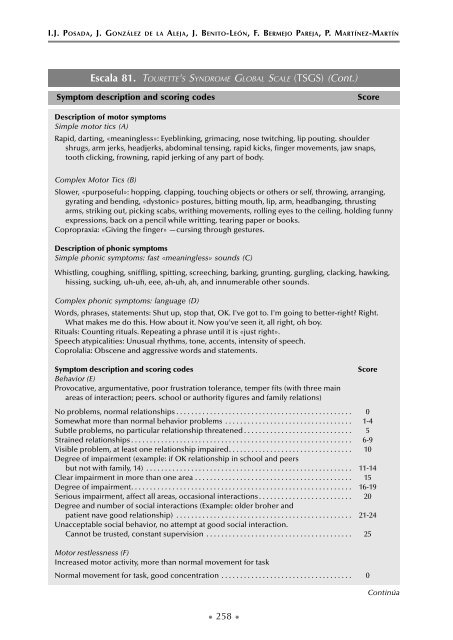Escalas en NeurologÃa - Sociedade Galega de Neuroloxia
Escalas en NeurologÃa - Sociedade Galega de Neuroloxia
Escalas en NeurologÃa - Sociedade Galega de Neuroloxia
Create successful ePaper yourself
Turn your PDF publications into a flip-book with our unique Google optimized e-Paper software.
12-ESCALAS (225-262) 3/6/08 12:54 Página 258<br />
I.J. POSADA, J. GONZÁLEZ DE LA ALEJA, J. BENITO-LEÓN, F. BERMEJO PAREJA, P. MARTÍNEZ-MARTÍN<br />
Escala 81. TOURETTE'S SYNDROME GLOBAL SCALE (TSGS) (Cont.)<br />
Symptom <strong>de</strong>scription and scoring co<strong>de</strong>s Score<br />
Description of motor symptoms<br />
Simple motor tics (A)<br />
Rapid, darting, «meaningless»: Eyeblinking, grimacing, nose twitching, lip pouting. shoul<strong>de</strong>r<br />
shrugs, arm jerks, headjerks, abdominal t<strong>en</strong>sing, rapid kicks, finger movem<strong>en</strong>ts, jaw snaps,<br />
tooth clicking, frowning, rapid jerking of any part of body.<br />
Complex Motor Tics (B)<br />
Slower, «purposeful»: hopping, clapping, touching objects or others or self, throwing, arranging,<br />
gyrating and b<strong>en</strong>ding, «dystonic» postures, bitting mouth, lip, arm, headbanging, thrusting<br />
arms, striking out, picking scabs, writhing movem<strong>en</strong>ts, rolling eyes to the ceiling, holding funny<br />
expressions, back on a p<strong>en</strong>cil while writting, tearing paper or books.<br />
Copropraxia: «Giving the finger» —cursing through gestures.<br />
Description of phonic symptoms<br />
Simple phonic symptoms: fast «meaningless» sounds (C)<br />
Whistling, coughing, sniffling, spitting, screeching, barking, grunting, gurgling, clacking, hawking,<br />
hissing, sucking, uh-uh, eee, ah-uh, ah, and innumerable other sounds.<br />
Complex phonic symptoms: language (D)<br />
Words, phrases, statem<strong>en</strong>ts: Shut up, stop that, OK. I've got to. I'm going to better-right? Right.<br />
What makes me do this. How about it. Now you've se<strong>en</strong> it, all right, oh boy.<br />
Rituals: Counting rituals. Repeating a phrase until it is «just right».<br />
Speech atypicalities: Unusual rhythms, tone, acc<strong>en</strong>ts, int<strong>en</strong>sity of speech.<br />
Coprolalia: Obsc<strong>en</strong>e and aggressive words and statem<strong>en</strong>ts.<br />
Symptom <strong>de</strong>scription and scoring co<strong>de</strong>s<br />
Behavior (E)<br />
Provocative, argum<strong>en</strong>tative, poor frustration tolerance, temper fíts (with three main<br />
areas of interaction; peers. school or authority figures and family relations)<br />
Score<br />
No problems, normal relationships . . . . . . . . . . . . . . . . . . . . . . . . . . . . . . . . . . . . . . . . . . . . . . . 0<br />
Somewhat more than normal behavior problems . . . . . . . . . . . . . . . . . . . . . . . . . . . . . . . . . . 1-4<br />
Subtle problems, no particular relationship threat<strong>en</strong>ed . . . . . . . . . . . . . . . . . . . . . . . . . . . . . 5<br />
Strained relationships . . . . . . . . . . . . . . . . . . . . . . . . . . . . . . . . . . . . . . . . . . . . . . . . . . . . . . . . . . . 6-9<br />
Visible problem, at least one relationship impaired. . . . . . . . . . . . . . . . . . . . . . . . . . . . . . . . .<br />
Degree of impairm<strong>en</strong>t (example: if OK relationship in school and peers<br />
10<br />
but not with family, 14) . . . . . . . . . . . . . . . . . . . . . . . . . . . . . . . . . . . . . . . . . . . . . . . . . . . . . . . 11-14<br />
Clear impairm<strong>en</strong>t in more than one area . . . . . . . . . . . . . . . . . . . . . . . . . . . . . . . . . . . . . . . . . . 15<br />
Degree of impairm<strong>en</strong>t. . . . . . . . . . . . . . . . . . . . . . . . . . . . . . . . . . . . . . . . . . . . . . . . . . . . . . . . . . . 16-19<br />
Serious impairm<strong>en</strong>t, affect all areas, occasional interactions . . . . . . . . . . . . . . . . . . . . . . . . .<br />
Degree and number of social interactions (Example: ol<strong>de</strong>r broher and<br />
20<br />
pati<strong>en</strong>t nave good relationship) . . . . . . . . . . . . . . . . . . . . . . . . . . . . . . . . . . . . . . . . . . . . . . .<br />
Unacceptable social behavior, no attempt at good social interaction.<br />
21-24<br />
Cannot be trusted, constant supervision . . . . . . . . . . . . . . . . . . . . . . . . . . . . . . . . . . . . . . . 25<br />
Motor restlessness (F)<br />
Increased motor activity, more than normal movem<strong>en</strong>t for task<br />
Normal movem<strong>en</strong>t for task, good conc<strong>en</strong>tration . . . . . . . . . . . . . . . . . . . . . . . . . . . . . . . . . . . 0<br />
� 258 �<br />
Continúa


